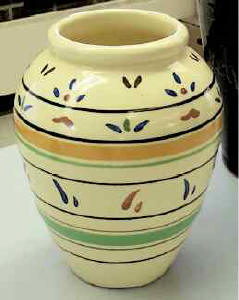|
©1999-2015 |
The following article appeared in WPA Press, Vol. 17, Summer 2003
WPA Members Present Ohio Potteries At our May 2003 meeting, Betty and David Knutzen and Elaine Staaland gave presentations on several Ohio potteries, in preparation for the WPA’s 2003 Show and Sale, entitled “Ohio Spectrum”. Elaine began the evening with her talk on Gonder Pottery. Known as Gonder Ceramic Arts, Inc., Gonder Pottery existed from 1941–57, a mere 15 years, in Zanesville, Ohio. G. Lawton Gonder bought the plant from Mrs. Mabel Hall McClelland, who succeeded her husband as owner of the Zane Pottery Co., which was earlier purchased from Peters and Reed. Lawton Gonder was raised in a pottery family—his parents both worked for Sam Weller at his Putnam plant. When the Gonders were married, Weller threw them a party. In addition to his parents work at for Weller, a close neighbor was John Herold, considered one of the great pottery authorities in the U.S. Herold frequently babysat for young Lawton Gonder. John Herold was known in part for the Chinese redware he made for Roseville. When he was 13, Lawton went to work for Herold at the Ohio Pottery Co., running molds and casting teapot parts.
In 1936 Gonder moved out of the tile business, becoming manager of the Florence Pottery where he applied glazes to Rumrill pieces. That plant burned in 1941. Lawton took Rumrill molds with him in 1941 when he started his own shop. For his designs Gonder went to some of the best sculptors and artists in the country. In addition, Gonder is credited with several artistic innovations in the ceramics field during his 15 years in Zanesville. One innovation was the development of flambe red glaze. This glaze resembles flames: it is red with yellow streaks throughout. Many or most of his Gonders pieces are characterized by a pink color on the inside. Gonder also created a gold crackle glaze. His Chinese crackle glazes earned him much attention. Gonder also developed what he called “Volcanic glazes”, using 2 glazes with different melting points. which resulted in a drip effect. Most Gonder pieces are marked with the name of the pottery, a mold number and sometimes “USA”. A few pieces were never marked, or were marked with a paper label. Dave Knutzen, in keeping with the Ohio theme, talked about RRP Co., Robinson Ransbottom Pottery. Started by the Ransbottom brothers, this pottery was first produced in the late 1890 but by 1906, the company had a staff of >100 and production was at 12,000 gallons of stoneware daily. By 1916, Ransbottom was the world’s largest producer of stoneware. In the early 1920s the Ransbottom pottery merged with Robinson Clay Products Company, which produced tile and brick products. At this time the product line expanded to include gardenware. The Robinson Ransbottom Pottery is still in production today. You can check the RRPC web site (www.ransbottompottery.com) for more information and to see handmade, rare pieces. Betty Knutzen talked about Zanesville Stoneware, another very old, Ohio pottery company. Many of their pieces are hard to place or give a date to, but this was the oldest Zanesville, Ohio pottery, dating back to the turn of the twentieth century. Zanesville Stoneware began by selling wholesale, primarily to other dealers and pottery companies. They made pieces for other companies, sometimes called “blanks”, labeling the pieces with the name of the company for which they were produced. Zanesville Stoneware pieces are known to be very heavy. The pottery’s largest pieces were produced by hand and some individual pots were made from 100lbs. of clay. The same clay pits have been used over the entire life of the pottery. Rubbleware was one of Zanesville’s trademark styles: these pots look like they are covered in brick. Early pieces of Zanesville stoneware were not glazed on the bottom center of the pot. Our thanks to Elaine, Betty and Dave for teaching us about some of the many and older Ohio potteries!! For more pictures from this presentation click here. Related Pages:
|









 Gonder
Pottery
Gonder
Pottery In
1915 Lawton went to work at American Encaustic Tiling Co., where he stayed for
11 years. He moved to Florida, then on to manage a New Jersey plant for
American Encaustic Tile. There Gonder supervised the production of the first
tiles guaranteed to not craze.
In
1915 Lawton went to work at American Encaustic Tiling Co., where he stayed for
11 years. He moved to Florida, then on to manage a New Jersey plant for
American Encaustic Tile. There Gonder supervised the production of the first
tiles guaranteed to not craze. 
